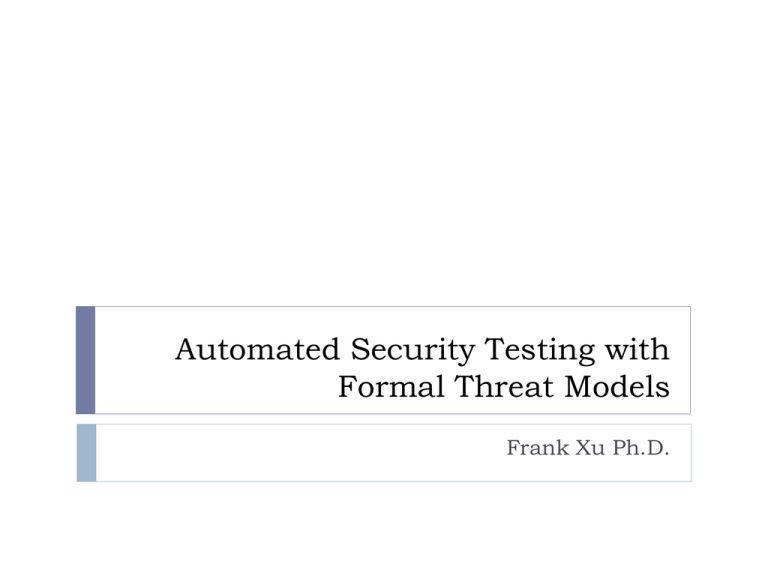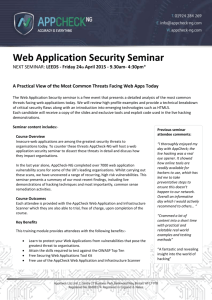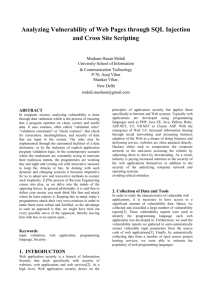Automated Security Testing with Formal Threat Models
advertisement

Automated Security Testing with
Formal Threat Models
Frank Xu Ph.D.
Overview
Introduction
Objectives
Approach
Experiments
Contribution & Conclusions
Introduction
Application security
Application vulnerabilities exceed Networking and OS vulnerabilities
Bypass authentication attack, SQL injection attack
Weak authentication mechanism, unsanitized inputs
Preventing malicious security attacks by detecting vulnerabilities
SANS' 2009 Top Cyber Security Risks (http://www. sans.org/top-cyber-security-risks/),
Introduction
How to detect software vulnerabilities?
Similar to detect software bugs
Security testing
Tradition testing vs. security testing
Traditional testing : test if a program does what it is supposed to do
Testing for security: test a program against possible vulnerabilities for
checking if it contains unintended behaviors
Sql injection to log into the system
Problem?
Security testing is very labor-intensive
Sql injection string: ' or '1'='1
databases, inputs, paths
Objectives
Presents an approach to automatically test
software security
Approach
Create formal threat models
Automatically generates all attack paths,
represented as Predicate/Transition nets
i.e., security tests
Converts attach path into executable test code
according to the given MIM (Model-Implementation Mapping)
specification
PrT net
http://www.informatik.uni-hamburg.de/TGI/PetriNets/introductions/aalst/elevator1.swf
Prt Net for dictionary attack
Notations
Variable Binding: ø = ?x/V
?x is bound to value V.
Variable Substituting: l/ø :
the tuple (or token) obtained by substituting each variable in l for its
bound value in ø.
If l= <?u,?p> and ø={?u/ID1,?p/PSWD1}, then l/ø=<ID1, PSWD1>.
l= (?u,?p)
P(ID1,PSWD1)
Enabled by ø={?u/ID1,?p/PSWD1},
Transition Enabled
Threat Model
SQL injection attacks
t11:do shopping,
t12: login
t13: check out”
t21: go to login page
t22: retrieve password
t23: forgot your password
t31: login,
t32: do shopping,
t33: check out using coupon code
sqlstr: or 1=1--, ‘) or ‘1’=’1--, and 1’ or ‘1=’1.
Generating Attack Paths
Generating Test Code
http://seleniumhq.org/movies/intro.mov
Model-Implementation Mapping
CASE STUDIES
Case Study I: Magento
Case Study II: FileZilla Server
Mutation (S.T.R.I.D.E. )
Spoofing, Tampering, Repudiation, Information disclosure, Denial
of Service, Elevation of privilege
Kill the mutations
Both studies show that security testing with formal threat
models is very effective.
They have killed 93.2% (41/44) and 96.7% (29/30) of the
mutants, respectively
Contributions & Conclusion
First, automated generation of executable security tests
from formal threat models is a novel contribution to
software security testing.
Injection of security vulnerabilities for evaluating the
effectiveness of security tests is a novel contribution to
mutation testing.











